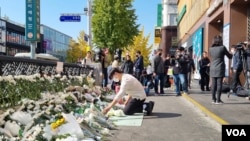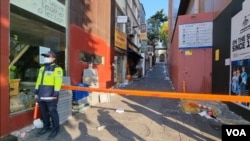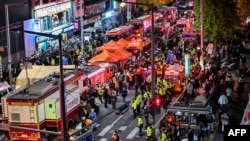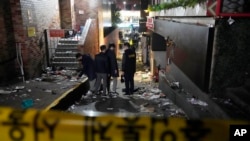Hours before dozens of Halloween party-goers were crushed to death in one of South Korea's deadliest peacetime disasters, Maeng Geun-yeong, a private security guard at a nearby bar, says he sensed something was not right.
Maeng, who was posted outside the Prost Pub & Grill directly above the tiny alley where the stampede occurred, was not surprised at the crowd size – around 100,000 people were gathered in Itaewon, according to media estimates.
It was Halloween weekend — the wildest party night of the year in one of Seoul's biggest entertainment districts – and young people on Saturday night seemed eager to let loose after over two years of social distancing.
What caught Maeng's attention was the absence of crowd control in the long path outside his pub, which is lined with nightclubs, restaurants, and karaoke bars. According to videos posted on social media, some areas were so dense it appeared difficult to move, long before the crush began.
The situation was so chaotic that the security guard said he warned his friends to avoid the area. Not only did he see no police patrolling outside his bar, officers never responded to calls when two women in the pub sustained minor leg injuries in an incident about two hours before the crowd surge, he said.
"The police just weren't there," said Maeng, a muscular 24-year-old, whose voice became wobbly as he alternated between anger and tears while recounting events leading up to the crowd surge that killed at least 154 people.
Maeng spoke to VOA on Monday after laying a bouquet of white flowers at a makeshift memorial on the sidewalk just below his workplace. "If police had been at the scene in advance, the accident could have been prevented," he said. "This happened because police were not deployed."
As South Koreans try to make sense of the Itaewon tragedy, Maeng is among many residents who say officials should have anticipated the massive Halloween turnout and either employed a much bigger police presence or more proactive crowd control measures to ensure orderly movement.
Police response
Police have defended their approach. They said 137 officers were initially sent to Itaewon, a larger number than recent Halloweens with large crowds, though it was not clear how many police were assigned to crowd control.
"This was not a problem that could have been solved by deploying police or firefighters in advance," said Lee Sang-min, South Korea's minister of Interior and Safety, who oversees police nationwide.
Many analysts concede that a larger number of police, especially in such a packed area, would not have necessarily prevented the crowd surge – in fact, it may have made things worse. Instead, what was needed was a better plan to accommodate the movement of large numbers of people, they say.
Some government officials have said managing the crowd was more difficult because there were no event organizers. Authorities also plan to investigate unconfirmed reports and rumors of business owners who locked their doors or who may have incited the crowd.
Police have not determined exactly what sparked the deadly rush, which resulted in hundreds of people being buried at the bottom of the small alley. But even without knowing the immediate cause, the situation becomes clearer when examining the space where the incident occurred.
Obstructed movement
The passageway is steep and narrow – only about four meters wide – with high walls. It is also non-descript, with only a small convenience store and a few other shops; there is seemingly no reason for such a large crowd to be there, unless they were trying to use the alley as a conduit connecting the upper and lower parts of Itaewon.
The problem, then, appears to have been one of movement – or the inability of the crowd to move at all, with each side pushing against the other and those on the bottom eventually losing their footing, reports suggest.
"Everyone wanted to use this [alley] as a shortcut," said Kim Young-ook, a professor at Seoul's Sejong University, whose academic bio references his studies "on the relation between spatial layout and spatial behavior."
Kim, who visited the Itaewon site Monday, is highly critical of the government's response. Police should have used more barricades, police lines, and other tools to manage crowd flow, he said. Kim thinks the alley in question should have been closed; others suggest it could have been made into a one-way street.
The bottom line: there should have been more planning, said Kim.
"This is not just a matter of it being a 'stampede,' or a problem with the road itself, or that the gathering had no organizer," Kim told VOA. "It is a matter of negligence."
"It is wrong to blame Itaewon business owners, or the people who came here, or the victims," Kim said. "The government and the police are responsible for the safety of the people – for any accident that occurs on the street or in the public square."
"That's a public road," he says, pointing to the alley where the crush occurred.
Misplaced priorities
For others, it's a problem of allocation of police resources. South Korean officials have confirmed a "considerable" number of police were deployed Saturday to manage crowds at political protests in other parts of Seoul.
For decades, South Korean authorities have routinely assigned massive numbers of police to even small demonstrations, which are a part of everyday life in Seoul. At the protests, police frequently use long lines of buses, temporary fences, and other barricades to manage small crowds.
Such strict protest management appears to be a remnant of South Korea's authoritarian military rule, which ended in the 1980s, said Mason Richey, associate professor of international politics at Seoul's Hankuk University of Foreign Studies.
Richey says it is legitimate to question the disparity between the resources devoted to protests and those devoted to the Itaewon event.
"Tell me where your manpower is and I'll tell you what you care about. And obviously, they clearly prioritize protests," Richey said.
"At the same time, I don't want them to swing back the other way," he added, expressing concern that all public gatherings would be over-policed.
Political fallout?
It is a precarious situation for South Korean President Yoon Suk Yeol, who has promised a thorough investigation into the crowd surge. Yoon, a conservative, is already unpopular. His approval ratings have hovered around 30% since taking office in May.
South Korea's last conservative president, Park Geun-hye, was brought down in part because of public fury over what was seen as her slow and inadequate reaction to the country's last major disaster – the 2014 sinking of the Sewol ferry, which killed about 300 people, mostly high school students.
"I think they had a blueprint this time for what not to do – don't be absent, don't be cold, be on the ground," said Richey, who said Yoon seems to have avoided major missteps with the Itaewon incident.
Others are not so confident about the government's response. Kim Han-gu, an Itaewon business owner, said he thinks some government officials are already trying to avoid taking responsibility.
"It's nonsense," Kim said, referring to the comments by the minister of Interior and Safety. "It needed to be managed better."
Maeng, the bar security guard, is also adamant that more police should have been on scene, and quicker.
"They could have stopped it," he said. "And yet they didn't come."















